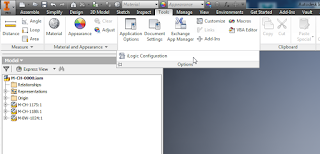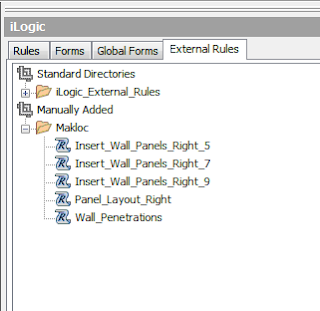Hey all, long time since my last post. I apologize for that. Busy is a good thing, right?
I recently had a chance to look at something in the Inventor API that I had yet to have a reason to: Hole Tables. A client was spending time on many drawings modifying a hole table column based upon the hole type. The holes are iFeatures and he could not find a way of adding this data to the iFeature so that it would populate in the hole table automatically.
This presented me with a chance to see what access we had to Hole Tables in the Inventor API.
First, I checked for a hole table and for a drawing view. If either doesn't exist then I'd warn the user.
' Declare variables
Dim oDrawDoc As DrawingDocument
oDrawDoc = ThisApplication.ActiveDocument
Dim oSheet1 As Sheet
oSheet1 = oDrawDoc.Sheets.Item(1)
' Check for a hole table
If oSheet1.HoleTables.Count = 0 Then
MessageBox.Show("Please ensure a hole table is present on the current drawing.", "No Hole Table",MessageBoxButtons.OK,MessageBoxIcon.Warning)
Return
End If
' Check for drawing views
If oSheet1.DrawingViews.Count = 0 Then
MessageBox.Show("Please ensure a drawing view is present on the current drawing.", "No Hole Table",MessageBoxButtons.OK,MessageBoxIcon.Warning)
Return
End If
Next, I cycled through the Hole Table columns to determine which column numbers were the columns that I needed to either get data from or write data to. If any of those columns don't exist then I'd warn the user.
' Declare variables
Dim oView As DrawingView
oView = oSheet1.DrawingViews.Item(1)
Dim oHoleTable As HoleTable
oHoleTable = oSheet1.HoleTables.Item(1)
Dim oRow As HoleTableRow
Dim oColumn As HoleTableColumn
' Cycle thru each column to determine the XDIM, YDIM, DESCRIPTION and CALLOUT columns.
iXDIMColumn = 1
For Each oColumn In oHoleTable.HoleTableColumns
oXDIMColumnName = oColumn.Title
If UCase(oXDIMColumnName) = "XDIM" Then Exit For
iXDIMColumn = iXDIMColumn + 1
Next
If iXDIMColumn > oHoleTable.HoleTableColumns.Count Then
MessageBox.Show("Please ensure hole table has a column named XDIM.", "No XDIM column",MessageBoxButtons.OK,MessageBoxIcon.Warning)
Return
End If
iYDIMColumn = 1
For Each oColumn In oHoleTable.HoleTableColumns
oYDIMColumnName = oColumn.Title
If UCase(oYDIMColumnName) = "YDIM" Then Exit For
iYDIMColumn = iYDIMColumn + 1
Next
If iYDIMColumn > oHoleTable.HoleTableColumns.Count Then
MessageBox.Show("Please ensure hole table has a column named YDIM.", "No YDIM column",MessageBoxButtons.OK,MessageBoxIcon.Warning)
Return
End If
iDescColumn = 1
For Each oColumn In oHoleTable.HoleTableColumns
oDescColumnName = oColumn.Title
If UCase(oDescColumnName) = "DESCRIPTION" Then Exit For
iDescColumn = iDescColumn + 1
Next
If iDescColumn > oHoleTable.HoleTableColumns.Count Then
MessageBox.Show("Please ensure hole table has a column named DESCRIPTION.", "No DESCRIPTION column",MessageBoxButtons.OK,MessageBoxIcon.Warning)
Return
End If
iCalloutColumn = 1
For Each oColumn In oHoleTable.HoleTableColumns
oCalloutColumnName = oColumn.Title
If UCase(oCalloutColumnName) = "CALLOUT" Then Exit For
iCalloutColumn = iCalloutColumn + 1
Next
If iCalloutColumn > oHoleTable.HoleTableColumns.Count Then
MessageBox.Show("Please ensure hole table has a column named CALLOUT.", "No CALLOUT column",MessageBoxButtons.OK,MessageBoxIcon.Warning)
Return
End If
Lastly, I checked the DESCRIPTION column and read it's text. The client had specific data that he would add to the CALLOUT column based upon the DESCRIPTION column. I did this with a Select Case but there are many other ways of accomplishing this. The client also wished to modify the CALLOUT column for any additional holes that are part of the same iFeature. I accomplished this by concatenating the XDIM & YDIM for all holes and if they matched the threaded hole then I modified their CALLOUT column as well.
' Cycle thru each row in hole table. Split Description column (5th) and set callout based on text for rows where XDIM and YDIM match.
For Each oRow In oHoleTable.HoleTableRows
oText = oRow.Item(iDescColumn).Text
Dim oTextLeft As String() = oText.Split(New Char() {"U"c})
sThreadData = oTextLeft(0)
Select Case sThreadData
Case "5/16-24 "
sCallout = "SAE2"
Case "7/16-20 "
sCallout = "SAE4"
Case "9/16-18 "
sCallout = "SAE6"
Case "3/4-16 "
sCallout = "SAE8"
Case "7/8-14 "
sCallout = "SAE10"
Case "1 1/16-12 "
sCallout = "SAE12"
Case "1 5/16-12 "
sCallout = "SAE16"
Case "1 5/8-12 "
sCallout = "SAE20"
Case "1 7/8-12 "
sCallout = "SAE24"
Case "2 1/2-12 "
sCallout = "SAE32"
Case Else
End Select
' Concatenate XDIM & YDIM
If Not sCallout = "" Then
sLocation = oRow.Item(2).Text & oRow.Item(3).Text
Call ChangeCallout(oRow,oHoleTable,sLocation,sCallout,iXDIMColumn,iYDIMColumn,iCalloutColumn)
End If
sCallout = ""
Next
End Sub
Private Sub ChangeCallout(ByVal oRow As HoleTableRow, oHoleTable As HoleTable, sLocation As String, sCallout As String, iXDIMColumn As Integer,iYDIMColumn As Integer, iCalloutColumn As Integer)
For Each oRow In oHoleTable.HoleTableRows
If oRow.Item(iXDIMColumn).Text & oRow.Item(iYDIMColumn).Text = sLocation Then
oRow.Item(iCalloutColumn).Text = sCallout
End If
Next
End Sub
The entire code is here:
Sub Main
' Declare variables
Dim oDrawDoc As DrawingDocument
oDrawDoc = ThisApplication.ActiveDocument
Dim oSheet1 As Sheet
oSheet1 = oDrawDoc.Sheets.Item(1)
' Check for a hole table
If oSheet1.HoleTables.Count = 0 Then
MessageBox.Show("Please ensure a hole table is present on the current drawing.", "No Hole Table",MessageBoxButtons.OK,MessageBoxIcon.Warning)
Return
End If
' Check for drawing views
If oSheet1.DrawingViews.Count = 0 Then
MessageBox.Show("Please ensure a drawing view is present on the current drawing.", "No Hole Table",MessageBoxButtons.OK,MessageBoxIcon.Warning)
Return
End If
' Declare variables
Dim oView As DrawingView
oView = oSheet1.DrawingViews.Item(1)
Dim oHoleTable As HoleTable
oHoleTable = oSheet1.HoleTables.Item(1)
Dim oRow As HoleTableRow
Dim oColumn As HoleTableColumn
' Cycle thru each column to determine the XDIM, YDIM, DESCRIPTION and CALLOUT columns.
iXDIMColumn = 1
For Each oColumn In oHoleTable.HoleTableColumns
oXDIMColumnName = oColumn.Title
If UCase(oXDIMColumnName) = "XDIM" Then Exit For
iXDIMColumn = iXDIMColumn + 1
Next
If iXDIMColumn > oHoleTable.HoleTableColumns.Count Then
MessageBox.Show("Please ensure hole table has a column named XDIM.", "No XDIM column",MessageBoxButtons.OK,MessageBoxIcon.Warning)
Return
End If
iYDIMColumn = 1
For Each oColumn In oHoleTable.HoleTableColumns
oYDIMColumnName = oColumn.Title
If UCase(oYDIMColumnName) = "YDIM" Then Exit For
iYDIMColumn = iYDIMColumn + 1
Next
If iYDIMColumn > oHoleTable.HoleTableColumns.Count Then
MessageBox.Show("Please ensure hole table has a column named YDIM.", "No YDIM column",MessageBoxButtons.OK,MessageBoxIcon.Warning)
Return
End If
iDescColumn = 1
For Each oColumn In oHoleTable.HoleTableColumns
oDescColumnName = oColumn.Title
If UCase(oDescColumnName) = "DESCRIPTION" Then Exit For
iDescColumn = iDescColumn + 1
Next
If iDescColumn > oHoleTable.HoleTableColumns.Count Then
MessageBox.Show("Please ensure hole table has a column named DESCRIPTION.", "No DESCRIPTION column",MessageBoxButtons.OK,MessageBoxIcon.Warning)
Return
End If
iCalloutColumn = 1
For Each oColumn In oHoleTable.HoleTableColumns
oCalloutColumnName = oColumn.Title
If UCase(oCalloutColumnName) = "CALLOUT" Then Exit For
iCalloutColumn = iCalloutColumn + 1
Next
If iCalloutColumn > oHoleTable.HoleTableColumns.Count Then
MessageBox.Show("Please ensure hole table has a column named CALLOUT.", "No CALLOUT column",MessageBoxButtons.OK,MessageBoxIcon.Warning)
Return
End If
' Cycle thru each row in hole table. Split Description column (5th) and set callout based on text for rows where XDIM and YDIM match.
For Each oRow In oHoleTable.HoleTableRows
oText = oRow.Item(iDescColumn).Text
Dim oTextLeft As String() = oText.Split(New Char() {"U"c})
sThreadData = oTextLeft(0)
Select Case sThreadData
Case "5/16-24 "
sCallout = "SAE2"
Case "7/16-20 "
sCallout = "SAE4"
Case "9/16-18 "
sCallout = "SAE6"
Case "3/4-16 "
sCallout = "SAE8"
Case "7/8-14 "
sCallout = "SAE10"
Case "1 1/16-12 "
sCallout = "SAE12"
Case "1 5/16-12 "
sCallout = "SAE16"
Case "1 5/8-12 "
sCallout = "SAE20"
Case "1 7/8-12 "
sCallout = "SAE24"
Case "2 1/2-12 "
sCallout = "SAE32"
Case Else
End Select
' Concatenate XDIM & YDIM
If Not sCallout = "" Then
sLocation = oRow.Item(2).Text & oRow.Item(3).Text
Call ChangeCallout(oRow,oHoleTable,sLocation,sCallout,iXDIMColumn,iYDIMColumn,iCalloutColumn)
End If
sCallout = ""
Next
End Sub
Private Sub ChangeCallout(ByVal oRow As HoleTableRow, oHoleTable As HoleTable, sLocation As String, sCallout As String, iXDIMColumn As Integer,iYDIMColumn As Integer, iCalloutColumn As Integer)
For Each oRow In oHoleTable.HoleTableRows
If oRow.Item(iXDIMColumn).Text & oRow.Item(iYDIMColumn).Text = sLocation Then
oRow.Item(iCalloutColumn).Text = sCallout
End If
Next
End Sub
"A very small man can cast a very large shadow" ~ Varys
Happy Coding!
Randy






